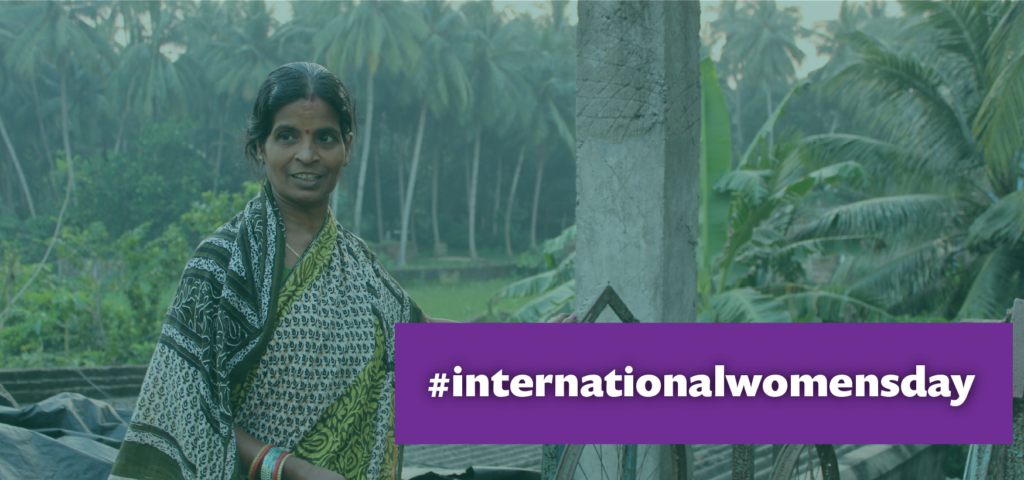The streets of Mexico City are filled with purple with tens of thousands of women, old and young, who march side by side. They wear purple to highlight the challenges women still face in Mexico.
This event happens in my hometown every International Women’s Day (IWD). Even when I am away from home, these women remind me to use this day to reflect on privilege, equality, gender, and the way ahead.
This year, for IWD, I joined a panel organized by the Food and Agriculture Organization (FAO), the International Fund for Agricultural Development (IFAD), and the World Food Programme (WFP) that focuses on Digital Innovation and Technology for Gender Equality.
During the panel, I shared my reflections about PxDs work, both on the progress I am proud to be a part of at PxD and the opportunities for us to do better in the future.

Here are a few of the things that I am proud to see at PxD:
We have better information on use and engagement by gender. We have improved our monitoring systems to have more information on our users, their engagement, and feedback. One of these improvements was to start collecting more information on gender, allowing us to understand women’s engagement better and incorporate that information into our design and decision-making processes.
We have developed services and content focused on women’s needs. Kitchen gardens are small plots of land where fruits, vegetables, and spices are grown for home consumption. Soon after launching a service focused on kitchen gardens, we realized that women often prefer the content on kitchen gardens over the general crop service. We think this is linked to the fact that they often have decision-making power over kitchen gardens but rarely over the primary crops that the family grows.
We have acknowledged that, as an organization, we are not yet gender experts, but we can partner with the best organizations in the sector to learn and improve our services. For example, our current partnership with SEWA Federation in Gujarat supports the delivery of crop advisory to women registered with the federation. These women seem to have a higher listening rate (almost 10 pp more) for the voice-based advisory messages compared to the average for all our registered farmers. The listening rate refers to the proportion of our calls that users listen to before hanging up. This sign of high engagement shows our content is relevant to their interests.
We have found a pathway to reaching more women by targeting activities they control, like dairy farming. Even though most of our users in Pakistan are male, 96% of the livestock and dairy program users are female. That program aims to equip rural women with better information about effective home-based livestock rearing and management, timely vaccination, and artificial insemination. By targeting dairy, a means of production they control, we can directly support them. Women are also heavy users of our dairy service in Kenya, where around 51% of users in our pilot were female.
Here are some opportunities for us to do better in the future:
Users of PxD services are still largely men. PxD often relies on government databases to identify potential users, and these databases tend to have a large proportion of male farmers. We have explored a few alternatives to increase the number of female users, but we need and want to do more. We will continue to explore partnerships and identify additional sources of information or alternative ways to reach women. As of the last quarter of 2022, we have increased the proportion of female farmers to 28%, which is a good improvement from previous years, but we still have room to grow.
We need to improve our impact on each woman who uses our service. This year IWD’s campaign highlights equal opportunities are not enough. We must continue to think about differential needs and services by gender, remembering that while having more women in each service is a goal, developing and implementing services tailored to their specific needs is also a priority. We have been successful to date with programs with kitchen gardens and dairy. We should continue to expand these services and identify similar opportunities that have the potential for a significant impact.
We need to design more services for women. While adapting our services to women and adding more women farmers to existing services helps address some of the digital divides, we need to understand better the unique constraints women in agriculture face, and their information needs, and identify effective ways of reaching them. For example, we have been working with the SEWA Federation to understand whether women’s groups might be effective ways to reach women, many of whom may not own a phone, to understand how information flows within these groups; and how technology may be able to address some of the informational asymmetries. We’re also pursuing large-scale partnerships with women’s groups in India, for example, through discussion with national and state-level rural livelihood missions to enable us to generate a wealth of insights and learnings on designing services that can effectively reach women in agriculture and meet their needs.
As we continue to grow as an organization and design and implement new programs, I look forward to learning more about how to serve female farmers better and incorporate those learnings into services that have the most significant possible impact on their livelihoods while considering the unique challenges that females face.